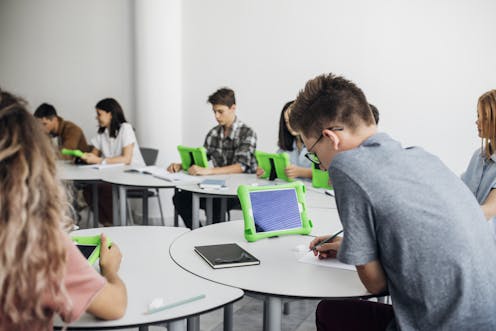Lots of schools are moving to 'hot desking'. Is there any benefit for my child?
- Written by Leon Benade, Associate Professor, School of Education, Auckland University of Technology

Some schools around Australia, and elsewhere, have replaced individual desks[1] with circular booths and shared tables for collaborative work.
But what does the evidence actually say? Do flexible learning spaces improve students’ ability to work together, as well as their learning overall?
The evolution of the classroom
For many parents, the schools their children attend are markedly different in design to the schools of their own childhood. This is because school design in Australia and New Zealand (and internationally) is challenging the traditional classroom[2] housing one teacher and 30 students seated in static, uniform desks and chairs.
This arrangement is being replaced by open-plan spaces accommodating several teachers working collaboratively with perhaps 100 students.
These new classrooms include include a profusion of colour, arrangements, styles and types of furnishing such as shared tables, mobile chairs, ottomans and beanbags.
The aim is to encourage students to move freely and collaborate. The arrangement also provides options for students to work individually if they please.
What’s the reason for these changes?
In its 2018 report The Future of Jobs, the World Economic Forum[3] pointed to the importance of “human” skills such as “creativity, originality and initiative, critical thinking, persuasion and negotiation” as workplaces change with technology.
The obvious place to begin acquiring these skills is school. In its 2013 Innovative Learning Environments[4] report, the OECD marked creativity, collaboration and digital literacy as of greater importance to a 21st-century workforce than traditional knowledge acquisition.
For at least the past two decades, teachers have focused increasingly on developing “21st-century skills”. They have learnt to accommodate the learning needs and styles of 21st-century children, while also learning to accommodate and embrace the development of technology. The result is teaching has shifted from teacher-centred instruction to student-centred and student-led learning.
Does non-traditional school furniture improve learning?
One of the arguments for a non-traditional furniture set-up is its design and flexibility enhance student engagement. A 2020 study[5] of ten classrooms in Texas with 206 elementary students in third and fourth grades reported the students experienced higher levels of enjoyment, comfort and attentiveness when using flexible furniture options.
Read more: Group tables, ottomans and gym balls: kids told us why flexible furniture helps them learn[6]
The study found flexible furniture afforded opportunities for collaboration and developing student autonomy. Importantly, this study also showed flexible furniture can positively influence teachers’ behaviour, given appropriate professional development support. This is because it liberates them from controlling students, who are allowed to move freely around the classroom.
Some local studies have made similar findings. A 2018 University of Wollongong[7] study found several factors enhanced student engagement and motivation, including students’ autonomous use of flexible furniture.
And a New Zealand study[8] recently found students made considered use of furniture choices in ways that reflected their conscious awareness of how the different kinds of furniture could support various learning activities.
There are possible negatives
Both Australasian studies reported, however, distractions and increased noise due to the sociability aspects of the range and type of furniture. These distractions led to off-task behaviour and lowered concentration levels in some cases.
Designers of modern school furniture claim a range[9] of physical and psychological health benefits for students. These include breaking the cycle of sedentary seated behaviour common in traditional school settings. Some parents[10] hotly contest this position and argue, for example, that options such as beanbags compromise children’s postures.
Read more: Classroom design should follow evidence, not architectural fads[11]
Similarly, the Wollongong and New Zealand studies questioned the health benefits of students sitting hunched over low tables or at backless ottomans. But both concluded free and frequent student movement reduced any postural concerns.
While inconclusive, the evidence does indicate 21st-century students of all ages prefer the option of being able to move around freely, to sit, slouch or lie wherever they are most comfortable, and to work with their peers on collaborative tasks.
Whether this leads to better academic outcomes than being seated at more traditional tables and chairs arranged in straight lines is yet to be researched. For the moment, the more permissive environment of modern and flexible learning spaces is making students more engaged, and that can’t be a bad thing.
References
- ^ replaced individual desks (www.afr.com)
- ^ traditional classroom (theconversation.com)
- ^ World Economic Forum (reports.weforum.org)
- ^ Innovative Learning Environments (read.oecd-ilibrary.org)
- ^ A 2020 study (link.springer.com)
- ^ Group tables, ottomans and gym balls: kids told us why flexible furniture helps them learn (theconversation.com)
- ^ 2018 University of Wollongong (link.springer.com)
- ^ a New Zealand study (link.springer.com)
- ^ claim a range (vsamerica.com)
- ^ Some parents (educationcentral.co.nz)
- ^ Classroom design should follow evidence, not architectural fads (theconversation.com)

















